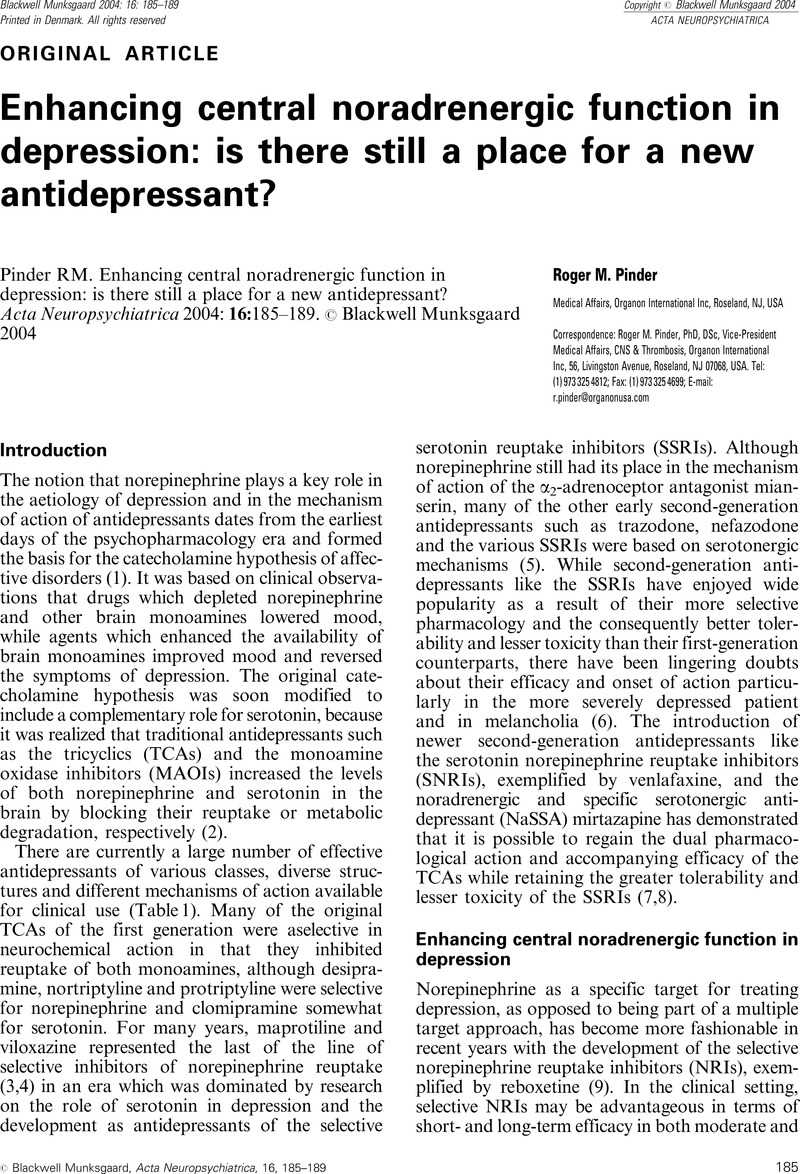No CrossRef data available.
Article contents
Enhancing central noradrenergic function in depression: is there still a place for a new antidepressant?
Published online by Cambridge University Press: 24 June 2014
Abstract
An abstract is not available for this content so a preview has been provided. Please use the Get access link above for information on how to access this content.

- Type
- Original Article
- Information
- Copyright
- Copyright © 2004 Blackwell Munksgaard
References
Schildkraut, JJ.
Catecholamine hypothesis of affective disorders: a review of the supporting evidence.
Am J Psychiatry 1965;130: 695–699.
CrossRefGoogle Scholar
Coppen, A.
The biochemistry of affective disorders.
Br J Psychiatry 1967;113: 1237–1264.CrossRefGoogle ScholarPubMed
Pinder, RM,
Brogden, RN,
Speight, TM,
Avery, GS.
Maprotiline: a review of its pharmacological properties and therapeutic efficacy in mental depressive states.
Drugs 1977;13: 321–352.CrossRefGoogle ScholarPubMed
Pinder, RM,
Brogden, RN,
Speight, TM,
Avery, GS.
Viloxazine: a review of its pharmacological properties and therapeutic efficacy in depressive illness.
Drugs 1977;13: 401–421.CrossRefGoogle ScholarPubMed
Pinder, RM,
Wieringa, JH.
Third-generation antidepressants.
Med Res Rev 1993;13: 259–325.CrossRefGoogle ScholarPubMed
Anderson, IM.
Selective serotonin reuptake inhibitors versus tricyclic antidepressants: a meta-analysis of efficacy and tolerability.
J Affect Disord 2000;58: 19–36.DOI: 10.1016/S0165-0327(99)00092-0CrossRefGoogle ScholarPubMed
Nierenberg, AA.
Do some antidepressants work faster than others? J Clin Psychiatry 2001;62 (Suppl. 15):22–25.Google ScholarPubMed
Smith, D,
Dempster, C,
Glanville, J,
Freemantle, N,
Anderson, I.
Efficacy and tolerability of venlafaxine compared with selective serotonin reuptake inhibitors and other antidepressants: a meta-analysis.
Br J Psychiatry 2002;180: 396–404.DOI: 10.1192/bjp.180.5.396CrossRefGoogle ScholarPubMed
Brunello, N,
Mendlewicz, J,
Kasper, Set al. The role of noradrenaline and selective noradrenaline reuptake inhibition in depression.
Eur Neuropsychopharmacol 2002;12: 461–475.CrossRefGoogle ScholarPubMed
Niklson, IA,
Reimitz, PE,
Sennef, C.
Factors that influence the outcome of placebo-controlled antidepressant clinical trials.
Psychopharmacol Bull 1997;33: 41–51.Google ScholarPubMed
Katz, MM,
Halbreich, UM,
Bowden, CLet al. Enhancing the technology of clinical trials and the trials model to evaluate newly developed, targeted antidepressants.
Neuropsychopharmacology 2002;27: 319–328.DOI: 10.1016/S0893-133X(02)00329-9CrossRefGoogle ScholarPubMed
Montgomery, SA,
Bech, P,
Blier, Pet al. Selecting methodologies for the evaluation of differences in time to response between antidepressants.
J Clin Psychiatry 2002;63: 694–699.CrossRefGoogle ScholarPubMed
Pinder, RM.
Designing a new generation of antidepressant drugs.
Acta Psychiatr Scand 1997;96(Suppl. 391): 7–13.CrossRefGoogle Scholar
Pinder, RM.
On the feasibility of designing new antidepressants.
Hum Psychopharmacol 2001;16: 53–59.DOI: 10.1002/hup.183CrossRefGoogle ScholarPubMed
Andrews, JS,
Pinder, RM.
Chemistry and pharmacology of novel antidepressants. In: Leonard, BE, ed.
Antidepressants. Basel: Birkhäuser, 2001: 123–145.
CrossRefGoogle Scholar
Nutt, DJ,
Pinder, RM.
α2-Adrenoceptors and depression.
J Psychopharmacol 1996;10(Suppl. 3):35–42.
Google Scholar
De Boer, TH,
Nefkens, F,
Van Helvoirt, A,
Van Delft, AML.
Differences in modulation of noradrenergic and serotonergic transmission by the alpha-2 adrenoceptor antagonists, mirtazapine, mianserin and idazoxan.
J Pharmacol Exp Ther 1996;277: 852–860.Google ScholarPubMed
Montgomery, SA.
Is there a role for a pure noradrenergic drug in the treatment of depression? Eur Neuropsychopharmacol 1997;7(Suppl. 1):S3–S9.DOI: 10.1016/S0924-977X(97)00414-8CrossRefGoogle Scholar
Skolnick, P.
Antidepressants: new pharmacological strategies. Totowa, NJ: Humana Press, 1997.
CrossRefGoogle Scholar
Leonard, BE.
Noradrenaline in basic models of depression.
Eur Neuropsychopharmacol 1997;7(Suppl. 1):S11–S16.DOI: 10.1016/S0924-977X(97)00415-XCrossRefGoogle ScholarPubMed
Delgado, PL,
Moreno, FA,
Potter, R,
Gelenberg, AJ.
Norepinephrine and serotonin in antidepressant action: evidence from neurotransmitter depletion studies. In: Briley, M, ed.
Antidepressant therapy at the dawn of the third millennium. London: Martin Dunitz, 1997: 140–161.
Google Scholar
Delgado, PL,
Moreno, FA,
Onate, L,
Gelenberg, AJ.
Sequential catecholamine and serotonin depletion in mirtazapine-treated depressed patients.
Int J Neuropsychopharmacol 2002;5: 63–66.DOI: 10.1017/S1461145702002778CrossRefGoogle ScholarPubMed
Mongeau, R,
Blier, P,
De Montigny, C.
The serotonergic and noradrenergic systems of the hippocampus: their interactions and the effects of antidepressant treatments.
Brain Res Rev 1997;23: 145–195.DOI: 10.1016/S0165-0173(96)00017-3CrossRefGoogle ScholarPubMed
Millan, MJ,
Lejeune, F,
Gobert, A.
Reciprocal autoreceptor and heteroreceptor control of serotonergic, dopaminergic and noradrenergic transmission in the frontal cortex: relevance to the actions of antidepressant agents.
J Psychopharmacol 2000;14: 114–138.CrossRefGoogle Scholar
Szabo, ST,
Blier, P.
Effects of the selective norepinephrine reuptake inhibitor reboxetine on norepinephrine and serotonin transmission in the rat hippocampus.
Neuropsychopharmacology 2001;25: 845–857.DOI: 10.1016/S0893-133X(01)00284-6CrossRefGoogle ScholarPubMed
Potter, WZ,
Schmidt, ME.
Noradrenergic and other new antidepressants. In: Halbreich, U,
Montgomery, SA, eds.
Pharmacotherapy for mood, anxiety and cognitive disorders. Washington, DC: American Psychiatric Press, 2000: 237–253.
Google Scholar
Amara, SG,
Kuhar, MJ.
Neurotransmitter transporters: Recent progress.
Annu Rev Neurosci 1993;16: 73–93.DOI: 10.1146/annurev.ne.16.030193.000445CrossRefGoogle ScholarPubMed
Porzgen, P,
Bonisch, H,
Bruss, M.
Molecular cloning and organization of the coding region of the human norepinephrine transporter gene.
Biochem Biophys Res Commun 1995;215: 1145–1150.DOI: 10.1006/bbrc.1995.2582CrossRefGoogle ScholarPubMed
Zill, P,
Engel, R,
Baghai, Tet al. Identification of a naturally occurring polymorphism in the promoter region of the norepinephrine transporter and analysis in major depression.
Neuropsychopharmacology 2002;26: 489–493.DOI: 10.1016/S0893-133X(01)00386-4CrossRefGoogle ScholarPubMed
Giros, B,
Wang, YM,
Suter, S,
McLeskey, SB,
Piff, C,
Caron, MG.
Delineation of discrete domains for substrate, cocaine, and tricyclic antidepressant interactions using chimeric dopamine–norepinephrine transporters.
J Biol Chem 1994;269: 15985–15988.CrossRefGoogle ScholarPubMed
Madras, BK,
Pristupa, ZB,
Niznik, HBet al. Nitrogen-based drugs are not essential for blockade of monoamine transporters.
Synapse 1996;24: 340–348.DOI: 10.1002/(SICI)1098-2396(199612)24:4<340::AID-SYN4>3.3.CO;2-J3.0.CO;2-D>CrossRefGoogle Scholar
Bylund, DB,
Eikenberg, DC,
Hieble, JPet al. International union of pharmacology nomenclature of adrenoceptors.
Pharmacol Rev 1994;46: 121–136.Google ScholarPubMed


